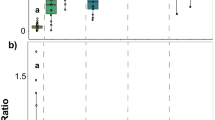Summary
Experiments with black locust (Robinia pseudoacacia L.) seedlings grown under strictly controlled laboratory conditions indicated that the availability of nitrate has a marked impact on nitrogen fixation. When nitrate concentrations were very low, both nodulation and seedling growth were impaired, whereas nitrate concentrations high enough to promote plant growth strongly inhibited symbiotic nitrogen fixation. When nitrate was added to the growth medium after infection, nodulation and nitrogen fixation of the seedlings decreased. This effect was even more marked when nitrate was applied before infection with rhizobia. Higher nitrogen concentrations also reduced nodule number and nodule mass when applied simultaneously with the infecting bacteria. The contribution of symbiotic nitrogen fixation to black locust shoot mass by far exceeded its effects on shoot length and root mass. When nitrate availability was very low, specific nitrogen fixation (i. e. nitrogenase activity per nodule wet weight) was improved with increasing nitrogen supply, but rapidly decreased with higher nitrogen concentrations.
Similar content being viewed by others
References
Awonaike KO, Lea PJ, Miflin BJ (1979) The effects of added nitrate on the enzymes of N-assimilation in Phaseolus nodules. In: Hewitt EJ, Cutting CV (eds) Sixth Long Ashton Symposium 1977. Nitrogen assimilatin of plants. Academic Press, London
Boring LR, Swank WT (1984a) The role of black locust (Robinia pseudoacacia) in forest succession. J Ecol 72: 749–766
Boring LR, Swank WT (1984b) Symbiotic nitrogen fixation in regenerating black locust (Robinia pseudoacacia L.) stands. For Sci 30: 528–537
Broughton WJ, Dilworth MJ (1971) Control of leghemoglobin synthesis in snake beans. Biochem J 125: 1075–1080
Davis JM, Keathley DE (1987) Differential responses to in vitro bud culture in mature black locust trees using tissue culture. Nitrogen Fixing Tree Res Rep 5: 57–58
Eaton FM, Harding RB, Ganje TJ (1960) Soil solution extractions at tenth-bar moisture percentages. Soil Sci 90: 253–258
Giller KE (1987) Use and abuse of the acetylene reduction assay for measurement of “associative” nitrogen fixation. Soil Biol Biochem 19:783–784
Hanover JW (1990) Physiological genetics of black locust (Robinia seudoacacia L.): a model multipurpose tree species. In: Werner D, Müller P (eds) Fast growing trees and nitrogen fixing trees. Proceeding of an International Conference held 8–12 October, 1989, Marburg, Federal Republic of Germany. Gustav Fischer, Stuttgart
Hebblethwaite PD (1983) The faba bean. A basis for improvement. Butterworth, London
Hoffmann G (1961) Die Stickstoffbindung der Robinie (Robinia pseudoacacia L.) Arch Forstw 10: 627–632
Keresztesi B (1988) The black locust. Academiai Kiado, Budapest
Keresztesi B (1990) Black locust: the tree of agriculture. In: Werner D Müller P (eds) Fast growing trees and nitrogen fixing trees. Proceedings of an International Conference, Marburg, Federal Republic of Germany, 8–12 October, 1989
Krijgsman OR (1990) Hungarian cultivars of Robinia pseudoacacia: much more than a “boutique” species. Tree Grower 1990: 24–26
Mengel K, Kirkby EA (1982) Principles of plant nutrition. International Potash Institute, Worblaufen-Bern, pp 70–71
Moiroud A, Capellano A, Bärtschi H (1982) Fixation d'azote chez les espèces ligneuses symbiotiques. I. Ultrastructure des nodules mycorhizes à vésicules et arbuscules ei activité réductrice de C2H2 de jeunes plants de Robinia pseudoacacia cultivés au loboratoire. Can J Bot 59: 481–490
Papen H, Werner D (1980) Biphasic nitrogenase activity in Azospirillum brasilense in long lasting batch cultures. Arch Microbiol 128: 209–214
Rhodes JD and Pope PE (1983) Effects of a vesicular-arbuscular mycorrhizal fungus and nitrogen-fixing bacteria on the growth of black locust. In: Thielges BA (ed) Proceedings 7th North American Forest Biology Workshop. Physiology and genetics of intensive culture. Lexington, University of Kentucky pp 341–349
Scheffer F, Schachtschabel P (1982) Lehrbuch der Bodenkunde. 11. Auflage. Ferdinand Enke, Stuttgart
Surles SE, Hamrick JL and Bongarten BC (1990) Mating systems in open-pollinated families of black locust (Robinia pseudoacacia) Silvae Genet 39:35–40
Udvardi MK, Day DA (1989) Electrogenic ATPase activity on the peribacteroid membrane of soybean (Glycine max L.) root nodules. Plant Physiol 90:982–987
Vincent JM (1970) A manual for the practical study of root nodule bacteria. Blackwell Scientific, Oxford
Werner D, Stripf R (1978) Differentiation of Rhizobium japonicum I. Enzymatic comparison of nitrogenase repressed and derepressed free-living cells and bacteroids. Z Naturforsch 33: 245–252
Werner D, Wilcockson J, Zimmermann E (1975) Absorption and selection of rhizobia by ion exchange papers. Arch Microbiol 105: 27–32
Wilson JK (1937) Scarification and germination of black locust seeds. J For 35: 241–246
Author information
Authors and Affiliations
Rights and permissions
About this article
Cite this article
Röhm, M., Werner, D. Nitrate levels affect the development of the black locust-Rhizobium symbiosis. Trees 5, 227–231 (1991). https://doi.org/10.1007/BF00227529
Received:
Accepted:
Issue Date:
DOI: https://doi.org/10.1007/BF00227529




